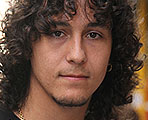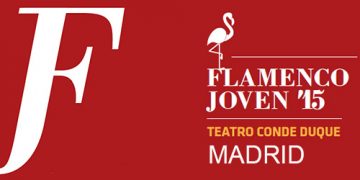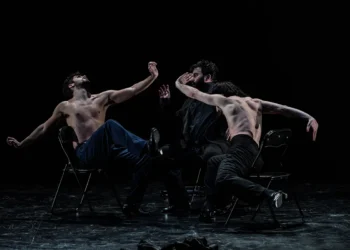Interview: Pablo San Nicasio
Photos: Rafael Manjavacas
«THERE IS NO FLAMENCO SONG, ONLY SINGERS»
|
Of the new crop of flamenco artists, the province of Huelva is lately providing the most prolific, encyclopedic and orthodox interpreters. We’ve always known that deep flamenco routes travel through the Odiel and the Tinto rivers, but what now seems more clear than ever is that it’s not only about fandangos. Jesús Corbacho has just debuted on the record market and, like others from his area, he defends a good assortment of forms that go beyond the legacy of Rengel, Isidro, Rebollo and company. In our Madrid shop we chatted with him about his still short flamenco life and his “Debajo del Romero”.
As far as the forms, it’s what I was looking for. Like you say, I wanted to do classic styles, and there’s a variety of cantes. There are also some tangos to bring flamenco to people who might not be familiar with more “difficult” forms so to speak. But it’s only logical. Everyone listens to “La Leyenda del Tiempo” sooner or later, and so what… It’s what I had in mind, thanks also to the Picap record company. They gave me complete freedom and respected my wishes to start right off the bat leaving no doubt that I’m a flamenco singer. That’s not easy. They heard me on the radio, they called me at home and they offered me the chance to make a record. And it was really a surprise. Look, it was shortly after your friend Manuel Moraga interviewed me. Of course I had to consider if it was the right moment, and I was thinking about it for two years. Until finally I got started with it, I didn’t want to trivialize anything. In fact, I had other offers, but they said “yes, but you have to focus it like this, it’s what we’d like…”. This record company does a lot of traditional Catalonian, Cuban and flamenco music. That makes them very respectful of the artists’ wishes and the tradition of each genre. Why does the siguiriya give the name to the whole thing? Well, rosemary (romero) is good luck, it’s an important cante on this recording, the siguiriya, and how the rosemary bush gets rid of the bad and brings the good. You allude to Niño Miguel right at the beginning. Yes, we more or less knew each other. I went to Seville for his reappearance, and he was happy to see me. In actual fact I felt the need to dedicate a piece to him. In Huelva not everyone knows the dimension of this man, it’s incredible. I’ve sung in the street with him now and again. What is there of your own creation on this record? The fandangos, bulerías and tangos, half and half with Juan Requena. There’s another piece by David Lagos. The rest is traditional or popular. There are other tributes as well. The zambra is for Caracol and the malagueña for Morente. Two highly stylized artists I admire a great deal. It was unforgettable, yes, I was lucky enough to have a cup of coffee with him, more or less, you know what I mean. He treated me like a colleague, him being a historic singer and at the same time so reachable. In Buenos Aires we had a pastry together, during the first flamenco Bienal of that city. I was in the show “Mujeres” with Merche Esmeralda, Belén Maya and Rocío Molina. I saw him when he came to see the show. But I felt funny saying hello to him. He came over and congratulated me. Even now it gives me chills to think of it. I had his record “Pablo de Málaga”, and he signed it: “To my friend Corbacho, a talented artist”. As far as “talented artist”, I don’t know, but to call me his friend shows his greatness. Morente set an example. “Even now it gives me chills to think of it. I had his record “Pablo de Málaga”, and he signed it: “To my friend Corbacho, a talented artist”. As far as ‘talented artist’, I don’t know, but to call me his friend shows his greatness. Morente set an example”. Colleague and artist, despite the fact that you have no professional flamenco artists in your background. No professionals, but my grandmother and my father for example, they were always singing fandangos, something that’s customary in Huelva. My father would put me to sleep singing fandangos, and I asked him to repeat them again and again. In any case, my mother seemed to know what was coming because she bought me a cheap guitar very early on, and she recorded me singing at the age of two and a half, there’s some of that on the record. Did you ever meet Toronjo? Yes, when I was a child, nine years old. I started playing at the Huelva flamenco club, so I went over to him and told him I really liked to sing. And he put his hands like this on my head and told me to keep on singing. But you were going to be a guitarist? Well, I learn some and even had some classes with Juan Carlos Romero. But I signed up at the fandango school and then won a children’s contest at eleven. At fifteen I won the adult contest. So I saw it was singing I wanted. Believe it or not, I once accompanied Arcángel for fandangos and alegrías at a benefit, I think there’s a video somewhere…we had a great time. Lots of things. They gave me a grant based on the contest, so I just went and moved to Seville. I was living at my aunt’s hours. It’s because of the Foundation I live in Seville, because I think it’s where the center of the action is for work right now. In Huelva there’s hardly anything except the flamenco cultural clubs. No tablaos or nightspots, so you can’t make a living off this. I sang for Alicía Márquez’ dance classes, and then I stood in for another singer on a tour with Pilar Ogalla and started to travel. That was when I began to notice the competition in this, and how hard it is. I was studying at the Foundation for one year. Then I became a monitor and sang directly for the dance classes of Milagros Mengíbar and Rafael Campallo. In other words, you really boned up. I paid attention in the classes and, well, it wasn’t bad. When you’re young and you have the kind of teachers they have there, Paco Taranto, José de la Tomasa, everything is easier. They teach you but they don’t obligate you to do anything, they let you express your personality. Each singer is different. Before all that, did you really have any cante teachers? Well, in fact it was a little of everything. My mother did her part buying me Camarón’s recordings, the flamenco forms by Antonio Mairena, she didn’t know much because she wasn’t really into this. I also gave some recitals at the women’s flamenco association of Huelva. My first siguiriya I learned from an anthology of Camarón’s, and another from a record of Tío Borrico, and in my first recital I sang five verses of siguiriyas, I don’t know how people kept from being bored…[laughter] Amparo Correa also taught me a lot, she promotes Huelva styles and fought for the cause, not only with me. “We might have the obligation of cultivating the most orthodox forms of Huelva, but we should be proud that others sing the forms of our province. Like when we sing bulerías and the people from Jerez like it”. What did those maestros think of your fandangos? We never got to that in the classes. We did other styles, it just came out that way. We looked at Triana cante in which they were experts. But you never stop learning, even though you’re from Huelva. The other day I heard a young guy sing fandangos and he did some really unusual things, you just never stop learning. Is the actual number of fandango styles registered anywhere? Antonio Gonzlález “El Raya” has them numbered in a book that received the prize of the Cátedra de Flamencología. Some forty-odd different styles. Very similar some of them, but different. And Huelva natives, what do you think of outsiders singing fandangos? How’s the level? Look, I think there are very few singers from outside who sing Huelva cante. And I think we natives are partly to blame. Lots of times we hear outsiders and we perk up our ears to hear how they do. And okay, we might have the obligation of cultivating the most orthodox forms of Huelva, but we should be proud that others sing the forms of our province. Like when we sing bulerías and the people from Jerez like it. It’s a form that gets some bad press, fandangos… The form cuts straight through to basics. In five lines of poetry it tells you about life. And it’s as great and difficult as any other style. We all know there’s no flamenco song, only singers. Do you still sing for dance? Yes, of course, with Marco Flores, Manuel Liñán…naturally. They are great dancers and I always learn with them.
|




 Four years ago from this very web you said you would strive to sing orthodox cante in your debut recording, and now that time has come. Have those plans changed much?
Four years ago from this very web you said you would strive to sing orthodox cante in your debut recording, and now that time has come. Have those plans changed much? From your years at the Cristina Heeren Foundation, what would you highlight?
From your years at the Cristina Heeren Foundation, what would you highlight?



















